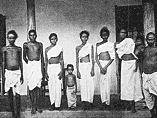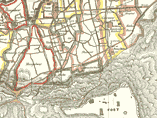 About the collection
About the collection
Institutions
The Medical History of British India collection uncovers a period of professionalisation and increased bureaucratisation in medical practice. Reports on institutions reveal the role of government and law and the operation of colonial power in a medical context.
Reports from medical colleges, schools and research institutions
Organisation of medical research
By participating in the development of 'laboratory medicine' in the colonies, which were partly independent of Britain, staff had an influence on the progress of medical practice in Britain itself as well as further afield. The colonies developed as sites of medical innovation – particularly in the new field of tropical medicine – resulting in skills transferring to the United Kingdom. Conversely, medical procedures observed in Britain were applied to India – for example, Joseph Lister's antiseptic regime, Sir Henry Thompson’s lithotripsy technique, and the use of the Wasserman test to detect syphilis.
The realisation that organised, centralised research was required to combat tropical diseases contributed to the opening of facilities for investigation and vaccine production. Between 1892 and 1907 laboratories opened in Agra, Kasauli, Bombay, Guindy and Coonoor, shaped by the new era of bacteriology and parasitology. The Government of India's Bacteriological Department was established in 1905, staffed mostly from the Indian Medical Service. Vaccination programmes, teaching hospitals, dispensaries and field teams illustrate that public health measures did indeed spread into the indigenous population. The motives and policies for this can be explored in these reports.
Importation of Western medicine
The teaching of 'European-style' medicine in India dates from the passing of a government order in February 1835. The opening of Calcutta Medical College saw traditional medicine abolished, the English language adopted and education based on the European model. Transmission of western medical education was rapid in Bengal: more natives, including women, became interested in enrolling.
The following years saw the establishment of schools in Madras (1835), Lahore (1860), Nagpur (1867) and Patna (1874). The reports show how these diversified by training candidates as sanitary inspectors, hospital assistants, army medical service subordinates and independent medical practitioners. Educating native doctors for military and civil need was regarded as beneficial to the people; they were engaged in mass vaccination programmes and were cheaper to employ.
Army health reports
Maintaining army health
The mid-19th-century rise of 'scientific' or 'hospital' medicine and the demise of the humoral model meant that European and Indian medicines became based on completely different understandings of the body. Western medicine acquired superior status and the British started campaigning against non-European forms of medicine, priding themselves on their scientific understanding of disease causation. The gulf between western and eastern medicine was further widened as English became India's official language.
The government became increasingly concerned with the health of the army after the Crimean War, and troop numbers had been severely depleted leading up to the Rebellion of 1857. The result of this was thorough examination and monitoring of the sanitary and medical arrangements for both British and native troops. Following the Royal Sanitary Commission report of 1863, it was realised that troops were dying from four major diseases – fevers, dysentery / diarrhoea, cholera and liver diseases.
It was imperative that troops were acclimatised and subsequently kept healthy, particularly as the Indian climate intensified disease. Placement of cantonments was determined by water, soil, air and elevation. Troops were segregated from the insanitary environment into more controlled conditions. The collection shows the extent to which colonial medical policy was 'enclavist'. However, severe outbreaks of disease often originated from troop movements and pilgrimages. These epidemics claimed many lives – the 1861 cholera epidemic killed one in 10 soldiers.
The health of the troops was further compromised by unsuitable heavy clothing, ill-fitting footwear, a meat-rich diet and a sedentary lifestyle. The Medical History of British India collection provides an opportunity to examine cantonment conditions and how colonial healthcare mostly benefitted European military personnel.
Indian Medical Service
By simultaneously protecting and utilising its manpower, the military's involvement in disease control was a considerable factor in the establishment of western medicine in India.
The Indian Medical Service consisted of doctors – known as 'surgeons' – lent for civil duty, operating in the field on a military basis. Formed in 17th century, the service’s main task was to supply medical officers to the army during war. Despite being accused of being slow to promote its staff and to act upon new medical trends, by the early 20th century the IMS had made advances in the prevention and treatment of cholera, plague, leprosy, smallpox and malaria in the native population.
Ronald Ross, S R Christophers, D D Cunningham and Leonard Rogers are among the scientists whose research while serving in the IMS is particularly significant.
Lock hospitals
Measures to halt venereal diseases
Lock hospitals were specialist institutions created for the treatment of venereal disease. These hospitals were provided in India following the introduction of the Contagious Diseases Acts of 1864 and 1868. There were two types of lock hospital: civil and military. There were, however, more military lock hospitals than civil, as venereal disease was an enormous problem among the British army in India. Annual reports were written by the authorities highlighting problems within the system and suggesting ways in which it could be improved. Generally the statistics rarely show any decline in the spread of venereal disease among the British soldiers.
Treatments for venereal disease
There is limited information in the lock hospital reports regarding the treatment of venereal disease. Registered prostitutes and soldiers are recorded as having been treated, but there is little explanation about method. Most lock hospitals encouraged cleanliness and good hygiene. Soap, water and towels were kept in all rooms to encourage this. Nitrate of silver is noted as being used in the treatment of venereal disease, but there are no records explaining its administration, the specific diseases, or its efficacy. Blackwash, a mixture of calomel and limewater, is documented as being used in the treatment of syphilis. Alum, zinc and other astringents appear – therefore treatments for venereal disease were evidently available.
Government attitude to prostitutes
The authorities showed little desire to prevent prostitution, only aiming to control it to prevent the spread of disease. There were two problems which are explored in the reports:
- Soldiers having intercourse with unregistered, often diseased prostitutes who lurked around the forts
- The lack of attractive-looking prostitutes in the regimental brothels.
The spread and increase in venereal disease was largely attributed to the prostitutes, while the soldiers were not encouraged to take responsibility for their actions. Sympathy for the native women, many of whom had resorted to prostitution to avoid poverty and starvation, was nonexistent. They received fines and imprisonment if they failed to attend examinations or if they were found to be practising prostitution unregistered.
Key subjects:
- Disease »
- Institutions
- Drugs »
- Veterinary
medicine » - Mental health »
- Vaccination »







